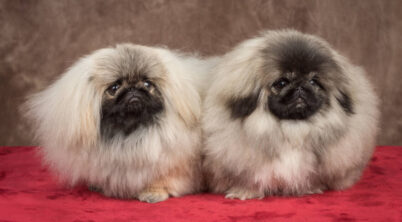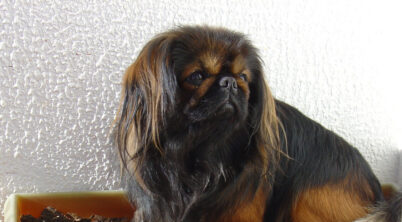The Pekingese breed, known for their long association with Chinese royalty, has a regal and ancient lineage that can be traced back to the imperial courts of ancient China. Bred to be the cherished companions of emperors and their families, these dogs have always been more than just pets; they represent a living piece of history. The Pekingese, with their distinctive lion-like mane and bold demeanor, carry themselves with a noble bearing that is a testament to their revered status among Chinese elites.
However, this princely breed can sometimes display signs of aggression, an issue that is not entirely uncommon in the canine world. Due to their history as pampered companions, Pekingese may develop territorial behaviors and exhibit a strong personality that can lead to aggressive interactions with other dogs or humans if not properly managed. As their imperial origins ensured they were always in close proximity to their owners, Pekingese tend to form very close bonds and may react poorly when they feel their territory or their human companions are threatened.
Addressing Pekingese aggression involves understanding their unique temperament and their need for consistent attention and socialization. Dog owners must acknowledge the breed’s background and inclinations, employing training techniques that emphasize positive reinforcement while setting clear boundaries. Careful attention to their social and physical needs can help mitigate aggressive tendencies, ensuring that these dogs of ancient lineage can adapt and thrive in the modern world as beloved pets.
Table of Contents
Pekingese Fighting
The Pekingese, renowned for its close association with Chinese royalty, originally served as a companion to emperors in the opulent halls of the Imperial Court. With their origin rooted in ancient China, the breed’s history is enveloped in the grandeur of the Tang Dynasty, enjoying the favor of figures such as Empress Dowager Cixi. These dogs held the esteemed title of “sleeve dogs,” a term that reveals their cherished role as miniaturized confidants peering out from the voluminous sleeves of the royal garments.
Pekingese were so valued that they resided within the Forbidden City’s walls, leading a life of luxury far removed from the concept of fighting. However, the breed’s history took a turn when British troops, during the Second Opium War, entered the Forbidden City. It was then that five Pekingese were found and brought back to England, which marked the beginning of the breed’s presence in the West.
The narrative of the Pekingese again intersected with a significant event during the sinking of the Titanic. Reports state that a Pekingese, named Sun Yat Sen, was one of the few canine survivors, illustrating the breed’s enduring presence alongside their human counterparts in times of turmoil.
Despite their regal and pacific origins, like any breed, Pekingese are capable of dog-to-dog aggression. Their interactions with other dogs can sometimes lead to altercations, which are usually more bluster and show than true combativeness, given their diminutive size and relatively peaceful disposition. When Pekingese engage with one another or with larger breeds, it is crucial for owners to understand their pet’s body language and thresholds to prevent such skirmishes.
Temperament and Behavior
The Pekingese breed is known for its dignified and sophisticated personality, often displaying a mix of affectionate loyalty and independent spirit. These dogs are alert and good-natured, but their strong-willed nature can sometimes be mistaken for aggression if not properly understood.
Personality Traits
The Pekingese, referred to as the “lion dog,” possesses a regal and confident character. They are often:
- Intelligent and Stubborn: They can be smart learners but may show a stubborn streak during training.
- Affectionate and Loyal: They typically form strong bonds with their families, making them excellent lapdogs.
- Independent and Dignified: Their independence means they need to be respected and not overly coddled.
- Vocal: They are not shy about using their voice, which can include barking to alert their owners.
Symptoms of Non-Fighting Related Aggression
Non-fighting related aggression in Pekingese may include:
- Growling or Snapping: These behaviors can occur when their personal space is invaded or when they are startled.
- Guarding Food or Toys: They may exhibit possessive tendencies.
Owners should address such behaviors with consistent training and socialization.
Compatibility with Children and Families
Pekingese can be friendly and compatible with families but consider the following:
- Not Ideal for Rough Play: Due to their small size, they are less suited for rough play with small children.
- Require Respect: They expect to be treated with gentleness and respect, which all family members should understand.
Understanding the temperament and behavior of Pekingese is crucial for fostering a harmonious relationship and preventing misunderstandings that may lead to aggression.
Training and Socialization
Effective training and early socialization are critical components in addressing aggression and behavior issues in Pekingeses. Establishing boundaries and using positive reinforcement can harness their intelligence and trainability for better manners and social skills.
Effective Training Methods
Training a Pekingese requires an understanding of their independent nature and intelligence. For optimal results, owners should employ the following strategies:
- Positive Reinforcement: Reward desired behavior with treats, praise, or play to reinforce good habits.
- Commands: Use clear and consistent commands like “come,” “sit,” “stay,” and “down,” to teach obedience.
- Crate Training: Introduce crate training to provide a safe space and instill routine, helping to establish clear boundaries and expectations.
Importance of Early Socialization
Early socialization plays a significant role in a Pekingese’s development. It involves gradually exposing the dog to a variety of people, animals, and environments to reduce fear and prevent future aggression. Strategies include:
- Planned Introductions: Always introduce new stimuli in a controlled manner.
- Consistent Exposure: Regularly expose the Pekingese to different situations to build their confidence and adaptability.
- Obedience Training: Enroll the Pekingese in obedience classes for social interaction with other dogs under professional guidance.
Properly socialized Pekingeses tend to be more even-tempered and less prone to aggression. Consistent, respectful training will leverage their natural intelligence and ensure they are well-adjusted companions.
Health and Care
The Pekingese breed requires attentive health management and care, which includes addressing common breed-specific health concerns, understanding their unique nutritional needs, and ensuring an appropriate level of exercise and activity.
Common Health Concerns
The Pekingese has a predisposition to certain health problems. Brachycephalic syndrome is common due to their short snouts, causing breathing difficulties and snoring. Eye issues such as cataracts can lead to blindness if not treated. Their long back and short legs, a result of chondrodysplasia, contribute to orthopedic problems. Regular grooming and brushing are essential to manage their long coat and prevent excessive shedding. They may also experience separation anxiety, which can affect their overall health.
Nutritional Needs
Proper nutrition is crucial for the Pekingese’s health. An AAFCO-approved diet ensures they receive a balanced intake of nutrients. Puppies should eat food formulated for their growth needs, while adults may require diets tailored to prevent dental issues or obesity. It’s imperative to monitor their calorie consumption, as the breed has a tendency to gain weight, which can exacerbate health issues.
Exercise and Activity Levels
Despite their small size, Pekingese possess a moderate level of energy and require daily exercise. However, due to their susceptibility to heatstroke and breathing issues, activities should be short and not too strenuous. Regular, gentle play and walks help maintain a healthy weight and provide mental stimulation. Owners should be careful to avoid overexertion, which can lead to further health complications.
* Banner photo by davemac61, cropped | Some rights reserved








